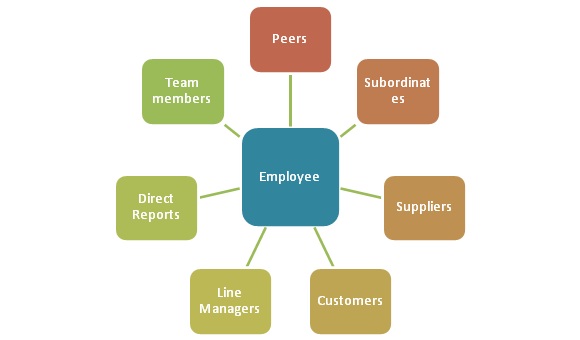- Business Concepts ›
- Human Resources (HR) ›
- 360 Degree Feedback
360 Degree Feedback - Definition, Importance & Example
This article covers meaning & overview of 360 Degree Feedback from HRM perspective.
360 Degree Feedback Definition
360 degree feedback is a system where an employee receives feedback from all the people around him related to business including the managers and the subordinates. In 360 degree feedback, a feedback about the employee is received from everyone with whom he has interacted with in the course of executing his job responsibilities. 360 degree feedback is obtained from peers, teammates, subordinates, direct reports and even external parties like suppliers, partners and vendors. It is also known as 360 Degree Assessment.
360 Degree Feedback is a type of feedback which is done by managers to understand the performance of an employee, and used in the appraisal process. This feedback is a part of the organizational feedback which is intended to improve the quality of employees in the workforce.
Importance of 360 degree feedback
It is essential for an organization to evaluate the performance of its employees. If an employee is under performing, they must be warned and if they are doing well, they must be rewarded. This can be done by understanding their performances based on a feedback. This is why 360 degree feedback is important to an organization.
This feedback may be used as an input to the performance appraisal process. It may also be used to identify competency gaps to administer relevant training to the employee. Such feedbacks can help in training & development programs of employees, and help in their career development. Important employee skills like leadership, time management, team management, communication management etc. can be developed. Similarly, a feedback from vendors & suppliers, known as 540 degree feedback is also used by companies.
This 360 degree feedback/assessment is also known as a multi-rater or multi source feedback as feedback about the employee is gathered from multiple sources and not just the reporting manager as in the case of a traditional performance appraisal system. A good and constructive feedback helps in employee motivation as well as helping in hearing out the employee voice.

The above image shows the 360 degree feedback of an employee based on reviews from peers, subordinates, suppliers, customers, managers & other team members.
Advantages of 360 degree feedback
There are several advantages of 360 degree feedback. Some of the benefits of such a feedback system are as below
1. It helps in evaluating the overall performance of an employee
2. 360 degree feedback gives a complete view of the work the employee has done, and just based on some supervisors review
3. This feedback shows all the competencies of an employee across various domains and verticals of business
4. Based on 360 degree feedback, new training programs can help develop the employee even more
5. The employee can work on his or her shortcomings based on the feedback given by everyone
Disadvantages of 360 degree feedback
There are certain drawbacks of this type of a feedback system. Some disadvantages of 360 degree feedback are:
1. Favoritism can affect the feedback of certain employees who otherwise must be working well
2. 360 degree feedback mostly gives qualitative feedback and might overlook the quantitative performance of an employee
3. Unfair feedback from some people may lead to an ambiguous ratings of the employee's performance.
Example of 360 degree Feedback
Let us imagine an organization hierarchy and sales department. Sales department hierarchy would be made up of Sales president, sales regional heads, sales managers and sales representatives. In 360 degree assessment of Sales managers, not only the regional heads would be giving feedback during appraisal but feedback would also be sought from the sales representatives who report to the sales manager. Similarly for assessment of regional heads, sales president as well as sales managers would provide feedback.
Hence, this concludes the definition of 360 Degree Feedback along with its overview.
This article has been researched & authored by the Business Concepts Team which comprises of MBA students, management professionals, and industry experts. It has been reviewed & published by the MBA Skool Team. The content on MBA Skool has been created for educational & academic purpose only.
Browse the definition and meaning of more similar terms. The Management Dictionary covers over 1800 business concepts from 5 categories.
Continue Reading:
What is MBA Skool?About Us
MBA Skool is a Knowledge Resource for Management Students, Aspirants & Professionals.
Business Courses
Quizzes & Skills
Quizzes test your expertise in business and Skill tests evaluate your management traits
Related Content
All Business Sections
Write for Us